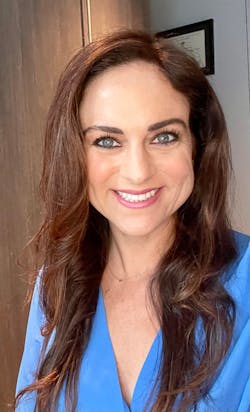Amber Auger, RDH, RDH Graduate editor, talked with Dr. Michelle Kelman about pediatric dental patients for her top recommendations and bits of wisdom when it comes to child patients.
Amber Auger, RDH: For new dental hygiene graduates, what do you feel are the five most important things an RDH needs to know before treating pediatric patients?
Dr. Kelman: First of all, it’s so wonderful to work with kids! It can be challenging, and it can be frustrating, but the smiles and hugs make it all worth it. After all, we’re keeping a child’s smile healthy, and that’s amazing.
Second, it’s important to understand that when you’re treating a child, you’re also teaching and training the family on how to maintain their child’s oral health. The trick is to teach both parents and kids at the same time. Always speak to the child directly. Make sure they trust you before you start any treatment. You need to be able to provide comfort while being authoritative as a key member of their oral health care team.
More pediatric-related reading
Recognizing developmental delays in pediatric patients
Fluoride and sealants: How these preventive tools are helping our pediatric patients
Third, the patient must trust you. How do you get a child to trust you and listen to you? How do you get a child to cooperate? Understanding children’s temperaments is essential. Every child is different and it’s important to notice this before they’re seated and to prepare mentally for your next steps, all while making the child feel comfortable. Try to understand how to handle different pediatric temperaments in a way that will lead to successful appointments.
Partnership with the parents will dictate success both in and out of the operatory. It’s essential to interview the parents. What is the oral health history in the family? Do the parents have a lot of plaque? Is the family prone to caries? Are there any mouth breathers? Does the child snore? Does the child suck their thumb or use a pacifier? These are essential questions. Be aware that oral habits are a sensitive issue, but they play a huge role in oral health. Also, determine if there are any sensory concerns. This is an important factor in treatment. Make sure you have “tasteless” paste on hand, keep a toothbrush close if noises are a concern, and always be compassionate.
Finally, apply your oral health knowledge when treating kids, who get plaque and gingivitis. Review the common causes of plaque buildup in pediatric patients, such as dry mouth, and understand oral patterns when a patient is at play and at rest. Know the common causes of caries in pediatric patients, such as how oral hygiene and diets can affect caries production in combination with genetics, birth factors, and hypomineralization.
Auger: When it comes to patient compliance, what do you recommend?
Dr. Kelman: I recommend instructing in a way that entertains children while making them feel accountable. Always give a child a mirror while they’re in the chair so they can watch how to take care of their teeth at home. I recommend telling them to brush in front of a mirror at home, even if it’s a compact mirror on a feeding table tray. Call in the parents when you’re giving the oral hygiene instructions (OHI) so you can teach them as well. I also recommend a home oral hygiene chart, which enforces accountability. Charts are a big help, especially if there are rewards involved.
Auger: When it comes to educating parents, what do you recommend?
Dr. Kelman: Never judge, at least not out loud. It’s important never to speak down to a parent or sound too authoritative. Building a trusting relationship with parents is the key to them understanding and complying. As I mentioned, OHI needs to be given to both the children and parents. I recommend having the parents demonstrate for you how they brush and (hopefully) floss their children’s teeth so you can review their home care routine. See what works best for the child versus the basic guidelines and rules we’re all taught. Discuss oral habits and nutritional habits and share recommendations, but again, do this with understanding and compassion toward the family’s situation.
Auger: How do you effectively communicate with your hygienists?
Dr. Kelman: Dental hygienists are well-trained and efficient. It’s important to partner through effective exams and handoffs. I want the RDH to focus on putting together the medical history, patient oral health, and diet information to allow me to more effectively treatment plan for long-term success.
Auger: What is different about the way you practice?
Dr. Kelman: I believe that hygienists in pediatric practices play a key role in patient care. Children deserve thorough cleanings with proper instrumentation at every visit (if this is possible based on patient behavior). The dentists and hygienists perform the cleanings in my office. Kids need real cleanings—scaler, prophy cup, and fluoride varnish. It’s essential to consistently stress the importance of oral health on overall health and to maintain a team of well-trained and competent clinicians who provide evidence-based oral medicine. Also, I encourage singing and dancing all day long. And I’m serious. All day.
Auger: How has your philosophy on treatment changed since you graduated?
Dr. Kelman: I graduated almost two decades ago, and a great deal has changed in medicine and dentistry. However, the one thing that has remained the same from my very first day of dental school is that I love working with children. But children have been through so much in the last few years and it’s important to consider that when treating them. I engage families more than I used to. I make them an active part of each appointment. I appreciate new technology, such as intraoral cameras and scanners. I’m able to show them plaque better, discuss how habits affect occlusion, and really explain what’s happening inside the child’s mouth. Also, thanks to the acceptance of medicaments such as silver diamine fluoride (SDF), we’re able to practice more conservatively and provide much better preventive care. I stress minimally invasive treatment from the first visit.
Michelle Kelman, DDS, is dedicated to exceptional pediatric and special needs oral health care. She founded the Pediatric Dental Center in the Cedars Sinai Medical Towers and was director and chief clinician from 2008-2021. She’s an active attending at the Cedars-Sinai Medical Center, a lecturer at the UCLA SOD, and served as an Adjunct Associate Professor at the USC SOD. Dr. Kelman lectures internationally to dentists and pediatricians on a variety of pediatric oral medicine topics.








